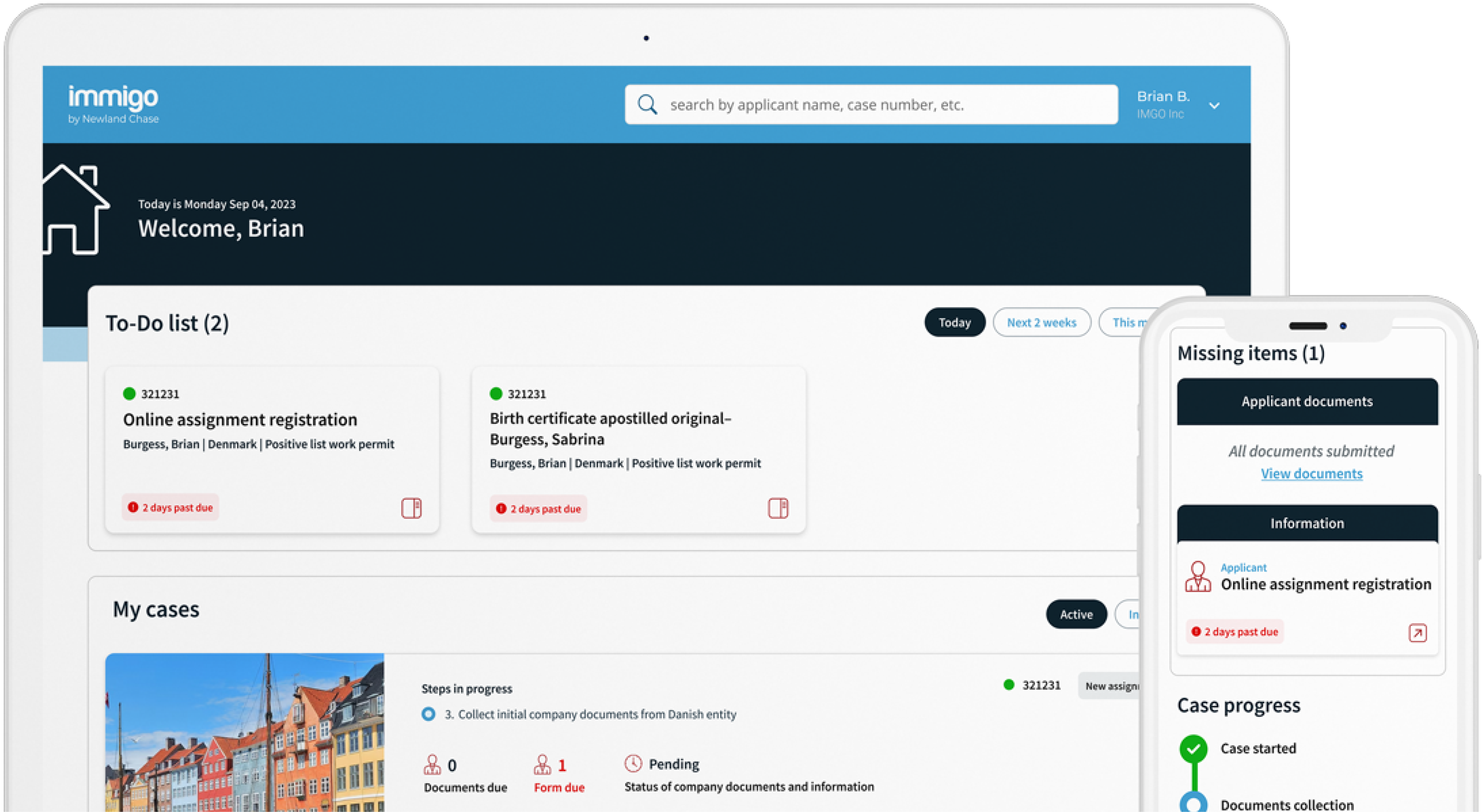Get The Visibility Your Company Needs
Reduce compliance risks and mobility costs while managing individual and project-related travel with ImmiSMART: the solution that unifies your travel and mobility programs.
2020 LOOK AHEAD: Global Business Immigration and Mobility Trends (Part 4 of 4)
February 7, 2020
By Jason Rogers, J.D., VP & Global Immigration Counsel, and Kent O’Neil, J.D.
We often note the passing of years – and particularly decades – with fanfare and a bit of introspection. In a greater sense, the flip of the calendar from 2019 to 2020 is more an artificial demarcation. When it comes to the international business environment, 2020 will present us with much of the same opportunities and challenges that 2019 did. Nevertheless, it is always prudent to periodically assess where we stand and where we’re going.
In preparing for the year ahead, we at Newland Chase did our annual look back at the significant changes in business immigration and mobility for 2019. If you missed it, take a look online here or download it in e-book format here. This week, looking ahead at 2020, here is how we view this year in global business immigration and mobility.
As always, please continue to monitor our blog and subscribe to our weekly newsletter – designed to keep international HR and mobility managers up-to-date and equipped with the latest changes and information for the year ahead. (Sign up on our home page here.)
This is part 4 in a four part look ahead at the global business immigration and mobility trends and developments to watch for in 2020. If you missed part 1 on global trends, you can find it here. Part 2 on North and South America is here, and part 3 on Europe and Africa is here. In this week's installment… Asia-Pacific and the Middle East regional trends and developments. Readers who would like the information in a single, savable and printable format to share with their teams are encouraged to download the complimentary 2020 LOOK AHEAD eBook coming soon here.
ASIA-PACIFIC
The shifting of the center of the global economy continues in the direction of Asia in 2020. While some decry the slowdown from recent years, the long-term prospects are still positive. In terms of business immigration and mobility, the general APAC region trend is toward openness and modernization to continue to attract talent and investment to the region.
China obviously tops the list of countries to watch in Asia. While the economic growth has moderated over the last year, China is still the world’s second largest economy and growing in size and importance. As discussed in our global trends above, the relationship between the U.S. and China will largely define the global economy and geopolitical climate.
Immigration policy was featured prominently in China’s economic plans in 2019, and that trend will likely continue into 2020. China needs to continue to fill its demand for talent in science and technology fields in order to fuel long-term growth and assert its economic independence. In the medium-term, that means a relatively friendly visa and immigration policy. The goal toward independence likely means the long-term strategy is to develop the needed talent in-country, but for now, recruiting foreign talent remains a necessary element of growth. Expect the focus of immigration policy to remain on recruiting highly skilled talent and retaining them long-term, as well as attracting back talented overseas Chinese.
China’s aggressive Belt and Road initiative will continue to exert greater economic influence around the world as China invests in infrastructure projects in developing countries. China’s influence as an economic partner is and will continue to increase beyond Asia, into Africa, South America, and Eastern Europe.
In India, popular and sometimes controversial Prime Minister Narendra Modi appears more focused on social policy than economic policy in 2020. Immigration is clearly on the agenda – but more in terms of illegal immigration, residency, and citizenship from neighboring nations than business- and employment-based immigration involved in international business.
India will continue to welcome foreign talent and investment to support a growing economy and population. Expect visa and immigration policy to essentially stay the current course through 2020, with only minor process changes increasing the use of technology in visas and the in-country residence registration process.
Singapore maintains his preeminence as an APAC international business hub, perhaps more so in 2020 with the ongoing challenges facing Hong Kong. Singapore’s visa and immigration system is already one of the most robust and technologically enabled it the world. Changes and challenges in 2020 for companies operating in Singapore will continue to be ensuring compliance with the Fair Consideration Framework as the Ministry of Manpower continues to be sensitive to protecting the local workforce.
In Australia, the wheels that will bring changes in immigration policy in 2020 already began spinning in 2019. The government has a continual process of evaluating its list of eligible occupations to keep it responsive to economic and labor needs in the country. The emphasis in 2020 will be on making the immigration system more responsive to regional needs. Companies will benefit from greater opportunities opening through immigration agreements and programs between the federal and regional governments. The new Subclass 491 Skilled Work Regional (Provisional) Visa and Subclass 494 Skilled Employer-Sponsored (Provisional) Visa, introduced in November last year, already demonstrated this trend toward responding to regional needs.
Japan continues to struggle with severe labor shortages across almost all sectors of its economy due to major demographic trends. Once considered almost isolationist in its immigration policy, the Japanese government is struggling to overcome this impression through new immigration and foreign labor laws. A major new immigration law was enacted in 2018 to address the problem, and key elements of that law are set to be implemented this year – including new visa categories and an online application system. We will be watching developments and analyzing opportunities for companies as the year progresses. This summer’s Olympic Games in Tokyo is likely to be a high-profile test of the new systems.
South Korea is expected to further relax visa requirements for citizens of Association of Southeast Asian Nations (ASEAN) member states in 2020. Expect other member states to further reciprocate in their visa policies as well.
MIDDLE EAST
The long-term visa and immigration trend in the Middle East is toward openness as the region’s countries seek to grow their economies beyond their dependence on oil production. Tourism is playing a greater factor in economic plans. In commerce and industry, retaining high skills foreign talent long-term and permanently is becoming a priority.
The United Arab Emirates remains the premier international business destination in the Middle East. No real surprises there. UAE visa and immigration processes will continue to receive favorable attention from the federal cabinet with continual improvements intended to retain more of its talented foreign population long-term.
Saudi Arabia seemed in a perpetual state of change regarding visas and immigration in 2019. While changes this year may be less frequent than last, we’re still watching for more changes – predominantly positive – in 2020. The Kingdom is already off to a busy start – announcing in January that visitors can now use existing UK, U.S., and Schengen area country visas to obtain Saudi visas upon arrival at the airports. Also, look for further expansion and improvements to the tourist e-visa program which debuted last year.
Did you miss any of the previous installment in this four part series? Get them here:
Need Expert Guidance?
Immigration laws and processes change every day. Some changes dominate global headlines, while other less publicized changes subtly but dramatically change the global business environment. To be successful in this climate, companies must quickly adapt and take action.
Newland Chase is uniquely positioned to quickly respond with guidance and strategic advice for our clients. Contact us today for a no-obligation consultation about your business immigration needs and how having Newland Chase as your trusted business adviser can help you succeed in the face of this challenging global business environment.
CONTACT US TODAY
Newland Chase, a wholly owned subsidiary of CIBT, is the leading global provider of immigration and visa services for corporations and individuals with over 1,700 expert immigration and visa professionals, attorneys and qualified migration consultants located in over 70 offices in 25 countries.
Jason L. Rogers, J.D. is Newland Chase’s Vice President and Senior Global Immigration Counsel. He is responsible for overseeing client immigration programs and providing high-level consultation responses for many of the world’s largest international companies. Jason has been practicing law since 2001 and has spent the past 12 years concentrating in the area of global immigration and corporate compliance. Jason received his Juris Doctor from Seton Hall University of Law and a Bachelor in Political Science from the University of North Carolina at Chapel Hill.
This publication is not intended as a substitute for legal advice. Readers are reminded that immigration laws are subject to change. We are not responsible for any loss arising from reliance on this publication. Please contact Newland Chase should you require any additional clarification or case-specific advice.




